WBBSE Madhyamika Model Question Paper History Group A
Choose the correct answer
Question 1 Mohan Bagan club won the IFA shield in the year-
1. 1890 AD
2. 1905 AD
3. 1911 AD
4. 1917 AD
Answer: 3. 1911 AD
Question 2 Dadasaheb Phalke was associated with-
1. Films
2. Sports
3. Local History
4. Environmental History
Answer: 1. Films
Question 3 The ‘Grambarta Prakashika’ was published from-
1. Jessore
2. Ranaghat
3. Kusthia
4. Barasat
Answer: 3. Kusthia
Question 4 The first BA Examination of Calcutta University was held in-
1. 1857 AD
2. 1859 AD
3. 1858 AD
4. 1860 AD
Answer: 3. 1858 AD
Question 5 The first Principal of Calcutta Medical College was-
1. Dr. N Wallich
2. Dr. M J Bramley
3. Dr. H H Goodeve
4. Dr. J Grant
Answer: 2. Dr. M J Bramley
Question 6 Titu Mir’s real name was-
1. Chirag Ali
2. Hyder Ali
3. Mir Nisar Ali
4. Torap Ali
Answer: 3. Mir Nisar Ali
Question 7 One of the leaders of the Sannyasi-Fakir rebellion was-
1. Rani Karnabati
2. Rani Shiromani
3. Debi Chaudhurani
4. Rani Durgavati
Answer: 3. Debi Chaudhurani
Question 8 The song ‘Bande Mataram’ was composed in the year-
1. 1870 AD
2. 1875 AD
3. 1872 AD
4. 1876 AD
Answer: 2. 1875 AD
Question 9 ‘Bartaman Bharat’ was written by-
1. Akshay Kumar Dutta
2. Rajnarayan Bose
3. Swami Vivekananda
4. Ramesh Chandra Majumdar
Answer: 3. Swami Vivekananda
Question 10 Gaganendra Nath Tagore was a-
1. Musician
2. Dramatist
3. Poet
4. Cartoonist
Answer: 4. Cartoonist
Question 11 ‘Barnaparichay’ was published in-
1. 1845 AD
2. 1850 AD
3. 1855 AD
4. 1860 AD
Answer: 3. 1855 AD
Question 12 Bengal Technical Institute was founded in-
1. 1905 AD
2. 1906 AD
3. 1912 AD
4. 1911 AD
Answer: 2. 1906 AD
Question 13 The first President of All India Kisan Sabha was-
1. N G Ranga
2. Swami Sahajananda
3. Baba Ramchandra
4. Lala Lajpat Rai
Answer: 1. N G Ranga
Question 14 The Congress Socialist Party was formed in-
1. Calcutta
2. Delhi
3. Bombay
4. Madras
Answer: 3. Bombay
Question 15 The Workers’ and Peasants’ Party was associated with-
1. The Rowlatt Satyagraha
2. The Non-Cooperation Movement
3. The Bardooli Satyagraha
4. The movement against the Simon Commission
Answer: 2. The Non-Cooperation Movement
Question 16 An attempt to assassinate Stanley Jackson, the Governor of Bengal was made by-
1. Bina Das
2. Kalpana Datta
3. Pritilata Waddedar
4. Suniti Choudhury
Answer: 1. Bina Das
Question 17 The secretary of the Anti-Circular Society was-
1. Sachindra Prasad Bose
2. Krishna Kumar Mitra
3. Chittaranjan Das
4. Anandamohan Bose
Answer: 1. Sachindra Prasad Bose
Question 18 The Vaikom Satyagraha took place in-
1. Malabar
2. Madras
3. Maharashtra
4. Godavari Valley
Answer: 1. Malabar
Question 19 The princely state which joined the Indian Union through plebiscite was-
1. Kashmir
2. Junagadh
3. Hyderabad
4. Jaipur
Answer: 2. Junagadh
Question 20 The linguistic state of Gujarat was formed in-
1. 1953 AD
2. 1956 AD
3. 1960 AD
4. 1965 AD
Answer: 3. 1960 AD
WBBSE Madhyamika Model Question Paper History Group B
Answer any sixteen questions, taking at least one from each sub-group
Answer each of the following questions in one sentence
Question 1 Who wrote the novel ‘Gora’?
Answer:
‘Gora’:
The novel ‘Gora’ was written by Rabindranath Tagore
Question 2 Write the name of the first illustrated book published in Bengali.
Answer:
The first Illustrated book Published in Bengali was Annada Mangal.
Question 3 In which year was the Serampore Mission Press founded?
Answer:
The Serampore Mission Press was founded in the year 1800 AD
Question 4 With which movement was Usha Mehta associated?
Answer:
Usha Mehata was associated with the Quit India movement of 1942
WBBSE Madhyamika Model Question Paper History Identify which of the following is ‘True’ or ‘False’:
Question 1 The editor of ‘Somprakash’ was Dwarka Nath Vidyabhusan.
Answer: True
Question 2 Kadambini Bose (Ganguli) was the first lady to be awarded the MA degree by Calcutta University.
Answer: False
Question 3 One of the leaders of the armed revolutionary movement in Bengal was Basanti Devi.
Answer: False
Question 4 Dipali Sangha was founded by Kalpana Dutta.
Answer: False
WBBSE Madhyamika Model Question Paper History Match Column A with Column B
| Column 1 | Column 2 |
| (1) Bankim Chandra Chattopadhyay | (A) Hindu Balika Vidyalaya |
| (2) Nabagopal Mitra | (B) Peasant movement |
| (3) Birendranath Sasmal | (C) Hindu Mela |
| (4) Drinkwater Bethune | (D) Bangadarshan |
Answer: 1-D,2-C,3-B,4-A
Question 1 On the given outline map of India, locate and label the following places:
1 Areas of Santhal Rebellion
Answer:
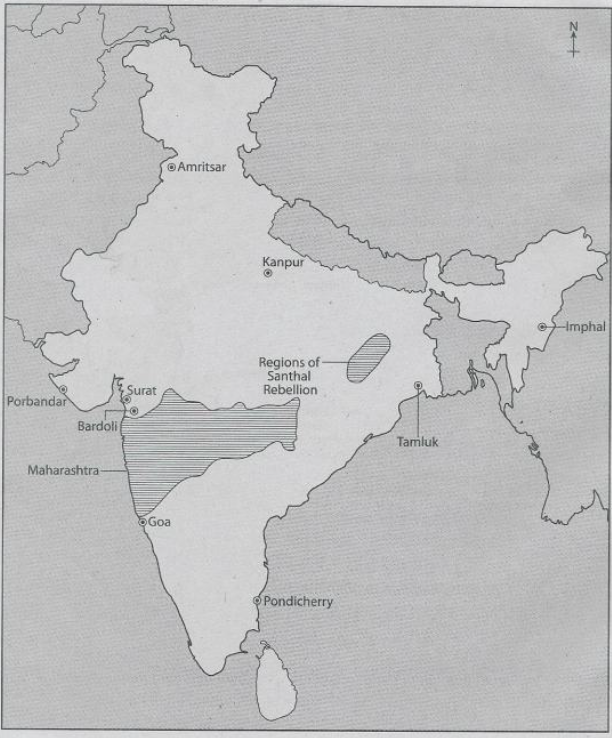
2 Areas of the Barasat Rebellion
Answer:
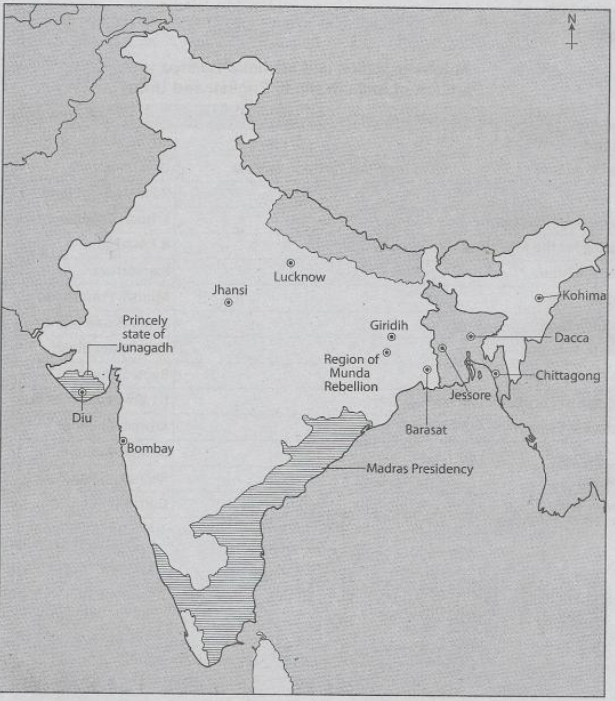
3 A center of Indigo Rebellion-Jessore
Answer:

4 Princely state of Hyderabad
Answer:
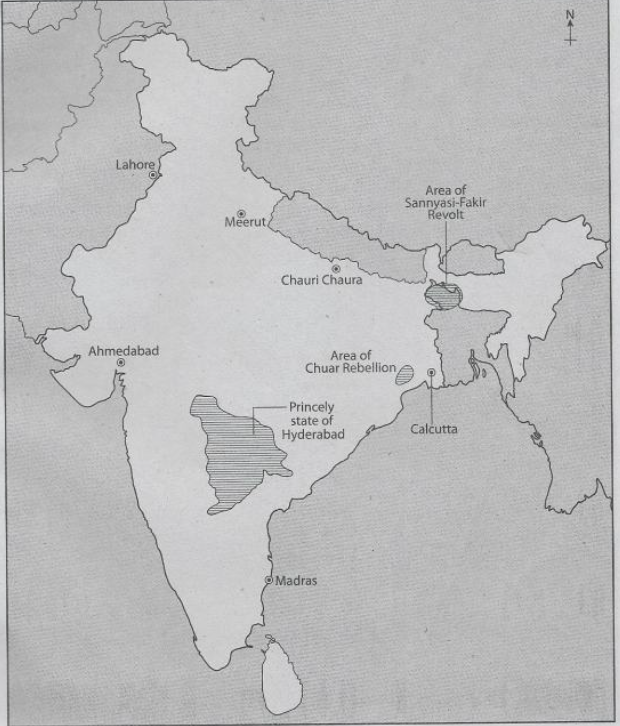
Select The Correct Interpretation Of The Following Statements
Question 1 Statement: Rammohan Roy wrote a letter to Lord Amherst (1823 AD)
Interpretation 1: Appealing to abolish the practice of Sati.
Interpretation 2: Appealing to spread western education in India.
Interpretation 3: Appealing to develop Sanskritic education in India.
Answer:
Interpretation 2: Appealing to spread western education in India.
Question 2 Statement: Swami Vivekananda wrote the book ‘Bartaman Bharat’.
Interpretation 1: His aim was to write a history of modern India.
Interpretation 2: His aim was to propagate Neo-Hinduism.
Interpretation 3: His aim was to spread patriotism.
Answer:
Interpretation 3: His aim was to spread patriotism.
Question 3 Statement: The anti-partition movement in Bengal did not enunciate any program for the peasants and working-class people.
Interpretation 1: The peasants and the workers were opposed to this movement.
Interpretation 2: The British Government Issued prohibitory orders on the peasant-working class agitations.
Interpretation 3: Anti-partition movement in Bengal was basically a Middle-Class Movement.
Answer:
Interpretation 3: Anti-partition movement in Bengal was basically a Middle-Class Movement.
Question 4 Statement: Gandhiji did not support peasant movements against zamindars.
Interpretation 1: Gandhiji was a representative of the zamindar class.
Interpretation 2: Gandhiji was against violent movements.
Interpretation 3: Gandhiji believed in the synthesis of classes as against class struggle.
Answer:
Interpretation 3: Gandhiji believed in the synthesis of classes as against class struggle.
WBBSE Madhyamika Model Question Paper History Group C
Answer the following questions in two or three sentences only (any eleven):
Question 1 What is the importance of the study of local history?
Answer:
Local history is the study of history in a geographically local context. It enables us to know the cultural, social, and economic aspects of a locality and its community.
It helps to study everything pertaining to a certain locality: History, Ethnography, Geography, National History, etc. The study of local history is a source for the reconstruction of National History.
Question 2 What are ‘government documents’?
Answer:
Government documents:
Government documents are the primary sources of information for reconstructing the history of India.
Government documents include:
(1) Records of the British officials,
(2) Police and intelligence reports,
(3) Official letters and correspondence,
(4) History recorded by English officers in the light of their own experiences.
Question 3 What is the difference between newspapers and periodicals?
Answer:
Differences between newspapers and periodicals are given below-
(1) Newspapers are usually published regularly and daily, whereas periodicals are published less frequently than daily newspapers.
(2) Newspapers contain different informative contents of everyday life, whereas periodicals give importance only to specific contents of the contemporary period.
(3) Newspaper articles are written by newspaper staff and do not provide authors’ names, whereas periodicals used subject experts for publication.
Question 4 Who was Madhusudan Gupta?
Answer:
Madhusudan Gupta was the first person in modern India to have dissected a human body. He was assisted by Raj Krishba Dey, Umacharan sett, Dwarkanath Gooptu and Nabin Chandra Mitra.
Question 5 Why did the Sannyasi-Fakir rebellion fail?
Answer:
The Sannyasi and Fakir Rebellion (1763- 1800) was unsuccessful due to various reasons, namely:
[1] The rebels failed because the leaders were inexperienced.
[2] Communication prevented them from fighting unitedly against the British.
[3] The rebellion was limited to a small region.
[4] The rebels were not popular among all classes of people.
Question 6 What was the role of the Christian Missionaries in the Indigo rebellion?
Answer:
The role of the Christian Missionaries in the Indigo rebellion:
The Christian missionaries who came from Europe played an important part in the Indigo Rebellion. They supported the cause of indigo cultivators. They expressed their views against the oppression and tyranny of the indigo planters and published these in newspapers.
Question 7 State two differences between the Landholders’ Association and the Indian Association.
Answer:
Two differences between the Zamindari Association and Bharat Sabha are as follows:
[1] The Zamindari Association was an association of landowners, zamindars, and rich businessmen whereas the Bharat Sabha was established with men from different sections of society.
[2] The primary objective of the Zamindari Association was to protect the interests of the landholders and zamindars whereas the primary objective of the Bharat Sabha was the general welfare of the people of India and the protection of their interests.
Question 8 What was the role of the painting ‘Bharatmata’ in the awakening of nationalism in the nineteenth century?
Answer:
The role of the painting ‘Bharatmata’ in the awakening of nationalism in the nineteenth century:
The famous image of ‘Bharat Mata’ was painted by Abanindranath Tagore. In this painting, Bharat Mata is portrayed as a four-armed Hindu Goddess wearing saffron-colored robes holding the Vedas, sheaves of rice, a ‘mala’, and a white cloth. It was an icon to create nationalistic feelings during the anti-partition struggle and Swadeshi Movement in 1905.
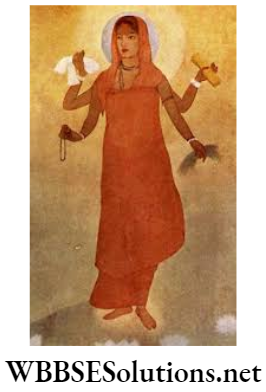
Question 9 Who was Charles Wilkins?
Answer:
Charles Wilkins:
Charles Wilkins, a British East India Company Official, set up a printing press at Chinsurah in Hooghly in 1778. He designed a Bengali script, a style of letters, for the first time with the purpose of printing. However, those letters were quite simple and of inferior quality.
Question 10 What was the importance of the introduction of linotype printing in Bengali?
Answer:
The importance of the introduction of linotype printing in Bengali:
Suresh Chandra Majumdar devised a set of letters known as ‘linotype’ which was a highly developed design of letters. It became one of the mainstay methods to set type. Nathaniel Brassey Halhed’s ‘A Grammar of the Bengal Language’ was printed using a linotype.
Question 11 What was the role of Baba Ramchandra in the peasant movement?
Answer:
The role of Baba Ramchandra in the peasant movement:
Baba Ramchandra gave leadership to the peasant movement in the United Provinces (present Uttar Pradesh). He became the leader of the Kisan Sabha of the United Provinces and built up a strong movement. Under his leadership, the movement of the Kisan Sabha merged with Gandhiji’s Non-Cooperation movement.
Question 12 Who was Madari Pasi?
Answer:
Madari Pasi:
Though the initial thrust of the Eka Movement was provided by the Congress and the Khilafat leaders, the leadership of this movement soon changed from Congress to Madari Pasi, a low-caste leader. This was because Madari Pasi was not inclined to accept non-violence ideology. Due to the violent nature of the movement, Congress stayed aloof from the movement.
Question 13 Why is Matangini Hazra remembered?
Answer:
Among the women who laid down their lives during the Quit India Movement was Matangini Hazra, a widow of 72 years, endearingly called ‘Gandhi Budi’. She led a crowd to occupy the Tamluk Police Station during the movement.
She became a martyr by carrying the national flag towards the Tamluk Court and embracing bullets till her death, shouting “Bande Mataram”. She is rightly called ‘Laxmi Bai of Midnapore’.
Question 14 Who are known as Dalits?
Answer:
Dalits:
From 1930, non-Brahmins, low caste Hindus, and the untouchables came to be known as ‘Dalits’. Gandhiji termed them as Harijans. They represented the most exploited and poorest section of society.
Question 15 Why was the Dar Commission (1948) formed?
Answer:
Immediately after the independence of India, there was a demand for the reorganization of states on the basis of a long urge. Consequently, the Linguistic Provinces Commission, headed by Justice SK Dar, was appointed in 1948.
Question 16 Who was Potti Sriramulu?
Answer:
Potti Sriramulu:
Potti Sreeramulu was a great freedom fighter. He led the movement in Andhra over the demand for a separate Andhra State. He undertook a fast unto death over this issue and even gave up his life for this cause.
WBBSE Madhyamika Model Question Paper History Group D
Answer the following questions in seven or eight sentences each.
Attempt one question from each Subgroup. Answer six questions in all
Question 1 What reflections of nineteenth-century Bengali society do we get from the drama ‘Nildarpan’?
Answer:
Among the literary works of the 19th century that portrayed the conditions of society, Dinabandhu Mitra’s ‘Nil Darpan’ deserves special mention.
[1] Background: Due to the heavy demand for indigo in the European cloth industry, European merchants and planters forced Indian farmers to plant indigo. This was the reason behind the problems in the lives of the farmers. ‘Nil Darpan’ portrayed the condition of the farmers and the oppression of the farmers and the sharecroppers.
[2] Condition of the farmers and indigo ryots: The European planters forced the farmers to cultivate indigo instead of wheat. This was the prime reason behind the food shortage that was seen in this period. On the other hand the farmers. were not given the right price for the crops cultivated by them. On top of the food shortage, the farmers now faced acute financial crises as well. This condition of the farmers was vividly portrayed in Nil Darpan.
[3] Torture: ‘Nil Darpan’ portrayed the condition of the ryots and the tortures they faced by ryots in the hands of the indigo planters. The planters not only forced the farmers to plant indigo but also evicted them from their lands and took away their properties.
[4] Indigo Revolt: Due to the inhuman torture faced by the Indigo farmers at the hands of the European planters, the farmers rose in revolt against this forceful cultivation of Indigo. This uprising of the farmers was known as Indigo Revolt. This revolt was portrayed by ‘Nil Darpan’.
Question 2 What role did Drinkwater Bethune play in spreading women’s education in the nineteenth century?
Answer:
John Elliot Drinkwater Bethune was an eminent poet, educator, and member of the Viceroy’s council. He is known for his contribution to promoting women’s education.
[1] Condition of women: After coming to India for official purposes, Bethune was grieved by the condition of the Indian women and he took initiative to introduce female education in the country.
[2] Establishment of schools: For the upliftment and progress of women’s education, he established the Hindu Mahila Vidyalay in Mirzapur, Calcutta. Vidyasagar was the president of the working committee of the school. He took the support of people such as Dakshinaranjan Mukherjee, Ramgopal Ghosh, and Madan Mohan Tarkalankar and donated all his movable and immovable property to the school.
[3] Establishment of college: To promote higher education among women Bethune established a women’s college which is at present known as Bethune College. The institution was started with the vision of producing successful enlightened generations of women.
Pritilata Waddedar, the famous freedom fighter, was a student at this college. Bethune college holds the singular distinction of being Asia’s first women’s college and has many implications in view of its continuing success in the field of higher education.
Question 3 What were the objectives behind the foundation of the Hindu Mela?
Answer:
The objectives behind the foundation of the Hindu Mela:
In 1867, the Hindu Mela, an annual festival was established in Calcutta-the main plank of which was Swadeshi or manufacture and use of indigenous consumer goods and the increased use of Indian languages. Big exhibitions of varied products of Indian arts and crafts were organized to encourage Indian producers to educate the general public about their own country.
The most significant objective of the Mela was the fostering of a unitary image of India and establishing institutions for imparting physical education, which involved exercises for building up the discipline and manhood of the nation, with a view to counter British imperialism and colonialism. Thus its main object was to foster a spirit of self-help among the Hindus and to promote all Indian integration through committees and slogans.
Question 4 Why is the ‘Bangabhasha Prakashika Sabha’ regarded as the first political organization?
Answer:
The Bangabhasha Prakashika Sabha is known to be the first political association. Its first session started on December 8, 1836. The Sabha regarded the government measured as highly injurious to the country.
The association discussed tropics connected with the policy and administration of the government and sought redressal by sending petitions and memorials to the government. It protested against the tax imposed on rent-free lands.
It decided to summon a public meeting to discuss the proposal of sending a petition to the government signed by five thousand persons. A circular was distributed widely among the people in Calcutta (Kolkata) and its neighborhood.
Thus it may be said that the founder members Dwarkanath Tagore, Kasinath Roy, and Prasanna Kumar Tagore were politically conscious and the Bangabhasa Prakashika Sabha established by them was the first political association.
Question 5 Explain the relationship between printed books and the spread of education.
Answer:
The relationship between printed books and the spread of education:
During the 18th and 19th centuries people of India were largely illiterate. With the introduction of printed books dissemination of knowledge became easy.
[1] Printed books were cheaper than handwritten books and the public could afford to buy printed books which helped in the dissemination of knowledge.
[2] The Bible, the Ramayana, the Mahabharata, and other Indian literary works, as well as various textbooks, were printed and translated into several languages such as Bengali, Hindi, Marathi, and so on. These translated books were made available to the people even in rural areas.
[3] Newspapers were printed and published, which helped in the dissemination of education among students and even among women.
[4] Cheaply printed books were made available to the students which helped in the spread of education among them.
[5] Literacy spread as more people were able to read in their mother tongue.
Question 6 What was the contribution of Dr. Mahendralal Sarkar to the cultivation of science in Bengal?
Answer:
The contribution of Dr. Mahendralal Sarkar to the cultivation of science in Bengal:
The Indian Association for the Cultivation of Science was established in 1867 by Mahendralal Sircar. It is one of the leading scientific institutions in India. It was the first national science association in India. Mahendralal realized that to achieve economic prosperity and hasten social change, it is necessary that Indians must cultivate science.
Basic departments such as Chemistry, Physics, Mathematics, Biology, and Spectroscopy were established. This institute is engaged in fundamental research in various branches of science. Lectures and demonstrations are arranged regularly for the public to popularise science.
Question 7 How did the Government of India tackle the question of integrating the princely states into the Indian Union?
Answer:
After the independence of India, the incorporation of the princely states posed a big problem. At the time of the transfer of power, the British government left these princely states free to join India or Pakistan.
All the states of free India, except Kashmir, Hyderabad, and Junagadh, immediately joined the Indian Union. Sardar Vallabhbhai Patel drafted the Instrument of Accession according to which the states were to be given freedom in their internal affairs and the Union Government was to have control over the defense and foreign policy of these states.
Most of the 562 states signed the Instrument of Accession. However, Junagadh, Hyderabad, and Kashmir did not agree to join India. The Indian troops invaded and occupied Junagadh.
The Nizam of Hyderabad tried to act like an independent ruler, but Indian police took action against him and Hyderabad was merged with India. The state of Jammu and Kashmir too acceded to India, but Pakistan refused to accept this merger. This led to wars with Pakistan.
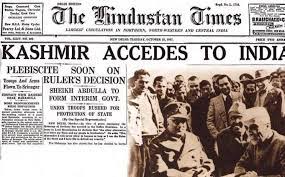
Question 8 How did the Kashmir problem originate?
Answer:
After India’s independence, when the most important princely state, Answer: Kashmir, declared to remain an independent state, it gave rise to certain problems.
[1] Attempts by Kashmir to maintain its independence: After India attained independence, both India and Pakistan asked Maharaja Hari Singh to accede into their respective nations. The Maharaja refused both offers and declared his wish to remain an independent state.
[2] Entry of the Pakistan army: The Pakistani government anticipated that the Hindu Maharaja might want to join India at some point of time. Consequently, on October 22, 1947, mercenaries supported by the Kashmir government infiltrated Kashmir. The Maharaja became helpless and asked for military help from India. India, in this backdrop, agreed to help him only if he agreed to sign the Instrument of Accession to the Indian Union.
[3] Signing the Instrument of Accession: The forces sent by Pakistan rapidly spread within Kashmir and moved towards Srinagar. This left Maharaja Hari Singh no choice but to sign the Instrument of Accession, and he signed it on October 26.
[4] Setting up of government: With the aid of the Indian army, the leader of the National Conference party in Kashmir, Sheikh Abdullah, took the control of the state. In the meantime, acting against Sheikh Abdullah, the part of Kashmir occupied by Pakistan was named ‘Azad Kashmir’ by the Pakistan government. From here, a number of attacks were launched on the region of Kashmir under Indian control.
[5] Appeal to the United Nations: India took up the Kashmir issue to the United Nations in order to protest against the infiltration by Pakistan.
[6] Ceasefire: In the backdrop of the constant conflicts between India and Pakistan in Kashmir, the United Nations declared a ceasefire on January 01, 1949. Due to this, a part of Kashmir came under the Indian Union, but Azad Kashmir remained a part of Pakistan.
As Pakistan did not get the whole of Kashmir, it has been launching several attacks on the other part of Kashmir ever since. Based on this issue, major wars have taken place between these two nations in 1947, 1965, 1971, and 1999.
WBBSE Madhyamika Model Question Paper History Group E
Answer any one question in fifteen or sixteen sentences:
Question 1 Give a brief account of the Widow Remarriage movement led by Vidyasagar. What was the extent of the success of Vidyasagar in this field?
Answer:
Widow Remarriage movement led by Vidyasagar:
Iswar Chandra Vidyasagar was a great social reformer. He gave a new dimension to the social progress of Bengal. He is remembered for his contribution toward the upliftment of women. He waged a long struggle for widow remarriage and tried to improve the condition of the suffering Hindu widows.
[1] Campaign in favor of widow remarriage: In order to save the widows from their miserable condition Vidyasagar launched campaigns advocating widow remarriage. In order to form public opinion in favor of the widow’s remarriage he wrote different essays in the Tattwabodhini Patrika. He urged the British to pass legislation in favor of widow remarriage and he collected almost 1000 signatures and sent his petition to the government.
[2] Widow Remarriage Act Passed: In 1856 the Hindu Widow Remarriage Act was passed which legalized the remarriage of Hindu widows. Vidyasagar played a pivotal role in passing the act.
[3] Widow remarriage performed: On December 7, 1856, under the supervision of Vidyasagar, the first lawful Hindu widow remarriage was held. In the years between 1856 and 1860, twenty-five widow remarriages were performed under his inspiration.
[4] The extent of success of Vidyasagar: The enactment of the Hindu Widow Remarriage Act, 1856 was one of the major social changes in 19th century India. Widow remarriage brought new life to the lives of the widows. Though the Widow Remarriage Act was opposed by the conservative section of society it was supported by DK Karve of Maharastra, Veersalingam Pantulu of Madras, and the Prarthana Samaj of Bombay.
But the Widow Remarriage Act could not drastically change the situation because many widows themselves in addition to men were opposed to this reform. Ban on widow remarriage was rooted in Hindu beliefs, family system, and social structure.
Question 2 Give a brief description of the development of Technical Education in Bengal.
Answer:
The development of Technical Education in Bengal:
Prior to the establishment of British rule in Bengal, there was no provision for western education that included modern technology. Technical education began to develop in Bengal in the 19th century.
Technical institutes: Along with the progress of science in Bengal, some educational institutions also grew up to impart technical education. Such institutes include Roorkee Engineering College (1847), Calcutta Engineering College (1856), Association for the Advancement of Scientific and Industrial Education, Calcutta (1903), Jadavpur Engineering College (1906), Bengal Technical Institute (1906), etc, Bengal Technical Institute was established by Taraknath Palit in Calcutta when the Swadeshi Movement (1905) started against the partition of Bengal.
Its contributions towards the spread of technical education are as follows-
[1] Initiative for national education: During the Swadeshi Movement, an attempt was made to establish a national system of education as an alternative to the education system of the British government. One of the objectives of national education was the spread of indigenous technical education. So Taraknath Palit, an Indian lawyer, founded the Bengal Technical Institute in Calcutta on July 25, 1906.
[2] Association with other institutes: In order to spread the indigenous system of education, Bengal Technical Institute merged with Bengal National College in 1910 and formed the Bengal National College and Technical School. This joint institution was renamed as College of Engineering and Technology (CET) in 1928.
[3] Activities: After the merging of the institutions, arrangements were made for the cultivation of various subjects like Physics, Chemical Technology, Industrial Technology, etc., besides the disciplines of Humanities. As a result, several educated Bengalee youths could receive technical education and become self-dependent.
Question 3 How did women participate in the anti-partition movement of Bengal? What was the limitation of their movement?
Answer:
Women participate in the anti-partition movement of Bengal:
Bengal was partitioned in 1905 by Lord Curzon. The Indians resisted the plan of partition to pressurize the British government to repeal the partition. In this context, women played an important role in the Anti-Partition agitation.
They were encouraged to come out of seclusion and take rightful steps in the national struggle. Women boycotted British goods and began to use indigenous goods. On the day of partition (October 16, 1905), they observed ‘Arandhan’ day. Sarala Devi Chaudhurani, through her journal ‘Bharati’, encouraged the women’s community to take part in the Anti-Partition Movement.
Sarojini Naidu traveled to various places and involved women participating in the boycott movement. Khairunnisa, through the journal ‘Nabanoor’, promoted the idea of Swadeshi among women as well. Women took part in the ‘Raksha Bandhan Utsav’ (October 16, 1905).
Women even donated money and ornaments to the Swadeshi fund. Among them, mention may be made of Kumudini Mitra, Lilabati Mitra, Nirmala Sarkar, etc. The Maharani of Natore also gave a call to the women to boycott British goods. community Ambujasundari Dasgupta of Jalpaiguri, the widow of Laxman Chandra (the zamindar of Mangalganj, Nadia), Punjalata Gupta of Mymensingh, Hemangini Das of Calcutta also made appeals to reject British-made goods.
Muslim women, however, did not directly participate in the movement, but only cooperated with their male counterparts. Women in large numbers did not participate in the Swadeshi Movement. The participation of women was confined to women of high-caste Hindu families. The movement could not spell its charm to attract low-class Hindu and Muslim women. Women did not have any effective organization or party of their own.
Plans and programs of the Swadeshi Movement were determined by their male counterparts who had no role to play. Though the Swadeshi Movement was a mass movement women’s activities were resented by the conservative section of society which discouraged many of them from taking part in the swadeshi movement.

